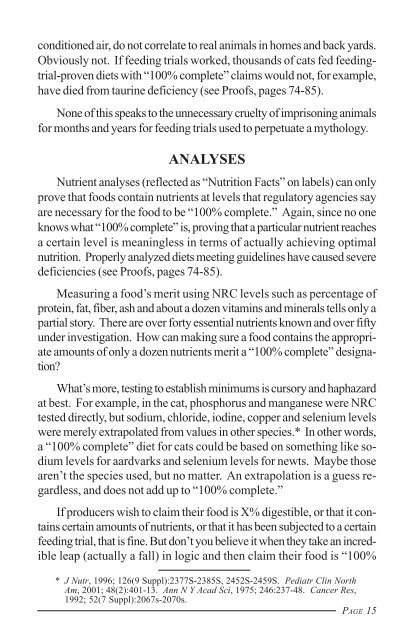The-Truth-About-Pet-Foods
The-Truth-About-Pet-Foods
The-Truth-About-Pet-Foods
Create successful ePaper yourself
Turn your PDF publications into a flip-book with our unique Google optimized e-Paper software.
conditioned air, do not correlate to real animals in homes and back yards.<br />
Obviously not. If feeding trials worked, thousands of cats fed feedingtrial-proven<br />
diets with “100% complete” claims would not, for example,<br />
have died from taurine deficiency (see Proofs, pages 74-85).<br />
None of this speaks to the unnecessary cruelty of imprisoning animals<br />
for months and years for feeding trials used to perpetuate a mythology.<br />
ANALYSES<br />
Nutrient analyses (reflected as “Nutrition Facts” on labels) can only<br />
prove that foods contain nutrients at levels that regulatory agencies say<br />
are necessary for the food to be “100% complete.” Again, since no one<br />
knows what “100% complete” is, proving that a particular nutrient reaches<br />
a certain level is meaningless in terms of actually achieving optimal<br />
nutrition. Properly analyzed diets meeting guidelines have caused severe<br />
deficiencies (see Proofs, pages 74-85).<br />
Measuring a food’s merit using NRC levels such as percentage of<br />
protein, fat, fiber, ash and about a dozen vitamins and minerals tells only a<br />
partial story. <strong>The</strong>re are over forty essential nutrients known and over fifty<br />
under investigation. How can making sure a food contains the appropriate<br />
amounts of only a dozen nutrients merit a “100% complete” designation<br />
What’s more, testing to establish minimums is cursory and haphazard<br />
at best. For example, in the cat, phosphorus and manganese were NRC<br />
tested directly, but sodium, chloride, iodine, copper and selenium levels<br />
were merely extrapolated from values in other species.* In other words,<br />
a “100% complete” diet for cats could be based on something like sodium<br />
levels for aardvarks and selenium levels for newts. Maybe those<br />
aren’t the species used, but no matter. An extrapolation is a guess regardless,<br />
and does not add up to “100% complete.”<br />
If producers wish to claim their food is X% digestible, or that it contains<br />
certain amounts of nutrients, or that it has been subjected to a certain<br />
feeding trial, that is fine. But don’t you believe it when they take an incredible<br />
leap (actually a fall) in logic and then claim their food is “100%<br />
* J Nutr, 1996; 126(9 Suppl):2377S-2385S, 2452S-2459S. Pediatr Clin North<br />
Am, 2001; 48(2):401-13. Ann N Y Acad Sci, 1975; 246:237-48. Cancer Res,<br />
1992; 52(7 Suppl):2067s-2070s.<br />
PAGE 15


